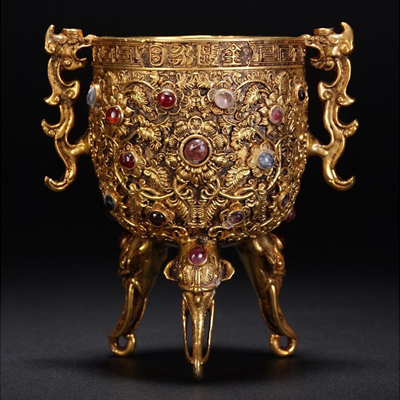Jinou Yonggu is considered one of the most beautiful and important works of art in ancient China. This gold wine cup, discovered in 1974, whose name means "The golden goblet remains strong forever", was specially designed for the 30th birthday of the Qianlong emperor, during the Qing dynasty (1711-99). It was used during the opening ceremony of the famous ball, held at midnight on the first day of the "Spring Festival". The emperor was the first to drink Tusu wine, followed by his imperial concubines, then the officials, which was a great honor for them.
The cup measures 12.5 centimeters high and 8 centimeters in diameter, the rim of the mouth is engraved with Chinese characters and the outer face is decorated with baoxiang flowers - a motif created from the combination of a lotus flower and a peony. The handles of the bowl are in the shape of dragons; the three feet are in the shape of elephant heads with long tusks and coiled trunks. Several precious and fine stones are inlaid around the rim of this piece, with a total of 11 pearls, 9 rubies, 12 sapphires and 4 pink tourmalines.
One of the most surprising things about this Chinese national treasure is that remains of iridescent blue Kingfisher feathers were found glued to the metal of the bowl. In those days, craftsmen would glue feathers of this bird, because of their great beauty, onto different types of art objects. I'll tell you more about this practice, called tian-tsui, in another article. The cup you see in the photo is carefully preserved in the Palace Museum in Beijing. tian-tsui, dans un autre article. La coupe que vous voyez dans la photo est précieusement conservée au Musée du Palais de Pékin.

